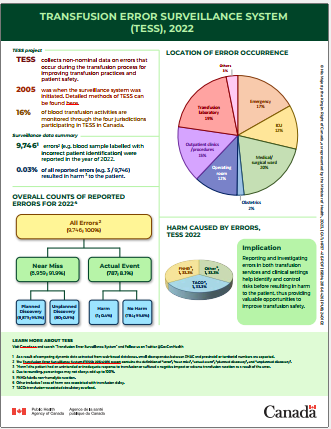Transfusion Error Surveillance System (TESS), 2022
Download in PDF format
(150 KB, 1 page)
Organization: Public Health Agency of Canada
Published: 2024-07-12
TESS Project
The Transfusion Error Surveillance System (TESS) collects non-nominal data on errors that occur during the transfusion process for improving transfusion practices and patient safety. The surveillance system was initiated in 2005. TESS now monitors four provinces and territories and 16% of blood transfusion activities in Canada. Detailed methods of TESS can be found in the Transfusion error surveillance system (TESS) : 2012-2016 report.
Surveillance data summary
- 9,746Footnote 1ErrorsFootnote 2 (e.g. blood sample labelled with incorrect patient identification) were reported in the year of 2022.
- 0.03% of all reported errors (e.g. 3 / 9, 746) resulted in harmFootnote 3 to the patient.
Overall counts of reported errors for 2022Footnote 4
- All ErrorsFootnote 2 (9,746; 100%)
- Near Miss (8,959; 91.9%)
- Planned Discovery (8,879; 99.1%)
- Unplanned Discovery (80; 0.9%)
- Actual Event (787; 8.1%)
- Harm (3; 0.4%)
- No Harm (784; 99.6%)
- Near Miss (8,959; 91.9%)
Location of error occurrence
- Transfusion laboratory 19%
- Outpatient clinics /procedures 15%
- Operating room 12%
- Obstetrics 2%
- Medical/ surgical ward 20%
- ICU 12%
- Emergency 17%
- Others 3%
Harm caused by errors, TESS 2022
- FNHRFootnote 5 1; 33.3%
- OtherFootnote 6 1; 33.3%
- TACOFootnote 7 1; 33.3%
Implication
Reporting and investigating errors in both transfusion services and clinical settings help identify and control risks before resulting in harm to the patient, thus providing valuable opportunities to improve transfusion safety.
Learn more about TESS
Visit Canada.ca and search "Transfusion Error Surveillance System" and Follow us on Twitter @GovCanHealth
Footnotes
- Footnote 1
-
As a result of comparing dynamic data extracted from web-based databases, small discrepancies between PHAC and provincial or territorial numbers are expected.
- Footnote 2
-
The Transfusion Error Surveillance System (TESS): 2012-2016 report contains the definition of "error", "harm", "near miss", "actual event", "planned discovery", and "unplanned discovery"
- Footnote 3
-
"Harm": the patient had an unintended or inadequate response to transfusion or suffered a negative impact or adverse transfusion reaction as a result of the error.
- Footnote 4
-
Due to rounding, percentages may not always add up to 100%.
- Footnote 5
-
FNHR: febrile non-hemolytic reaction.
- Footnote 6
-
Other includes: 1 case of harm was associated with transfusion delay
- Footnote 7
-
TACO: transfusion-associated circulatory overload
